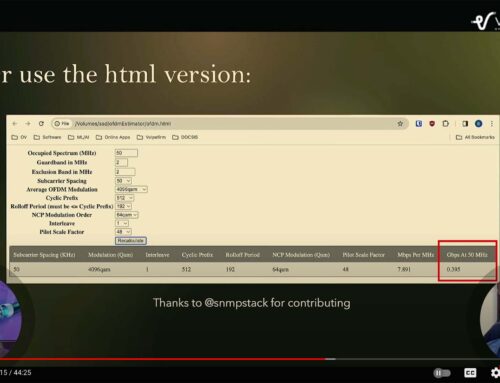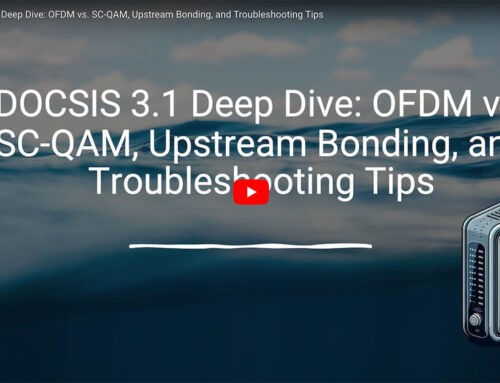In this post I am going to focus on VoIP packet loss, which is just one of the three (3) primary types of VoIP impairments that are present in a DOCSIS network. I will cover many RF and IP terms in this blog that I have not discussed in my previous tutorials, not to worry! This terminology is all fodder for future blogs.
To review, the three fundamental impairments which impact call quality of VoIP communications are as follows:
- Packet Loss – The complete or partial loss of a packet containing actual voice payload.
- Delay – The time a packet takes to traverse the space between the source and destination of a voice call. The space is comprised of both the physical distance the data must travel in addition to the active network routing and switching elements, which contribute additional delay.
- Jitter – The variance of inter-packet arrival time from one transmitted packet to the next sequential packet.
The manifestation of each of these impairments can occur at any or a combination of the three levels of the DOCSIS communications network as defined in the following figure.

DOCSIS Hierarchy
The magnitude of each of these impairments may be cumulative and will have perceptible yet subjective impacts on the call quality. The effectiveness of impairment cancellation algorithms will ultimately determine the level of impairment that a voice call can sustain while maintaining a certain call quality.
The following sub-sections will focus on the source, impact, and possible resolutions for each packet loss, jitter, and delay.
Packet Loss
VoIP packets traversing an IP network residing over a DOCSIS network can drop frames for a variety of reasons ranging from the physical layer to the IP layer. The impact of lost packets on a voice call is dependent upon the number of lost packets. Assuming that each packet contains exactly 20 ms of encoded speech, the loss of just one packet will most likely be unperceived by the caller, while multiple packet losses will cause the caller to miss portions of the voice from the caller on the other end. The net effect is a call which is missing parts of words or complete words. So in the analysis of packet loss, a percentage of lost packets are used to quantify the voice impairment. In the case of G.711, a packet loss of 0% will have no Ie contribution. (Refer to VoIP Impairments Blog for Ie and R-Factor details). A packet loss of 2% will have an Ie value of 35 and packet loss of 5% will have an Ie value of 55. So referring back to Table 1 and assuming no contribution from other impairments, the following table represents the degradation of a voice call for packet loss of only 2% and 5%.

Packet Loss
So clearly, loosing only 1 in 50 packets (2 %) will create a call that nearly all users will be dissatisfied with under normal conditions. In this case, the caller must have a substantial reason to accept this poor quality, such as very low toll costs or convenience (as in the case of cell phones), such that the Advantage factor (A) in the R factor equation will compensate for the poor call quality. In the case of 5% packet loss (1 packet in 20), a call is considered not acceptable.
Now that the impact of packet loss is understood, it is important to understand the possible sources of packet loss in an IP delivered DOCSIS network. Starting from the bottom and working up, the physical layer (RF plant) is first examined. Physical layer generated packet loss is usually the result of RF interference, linear, or non-linear RF impairments, such as group delay. Typically the downstream path in the HFC (CMTS to CM) contributes little or no packet loss, provided a post-FEC BER of 10e-8 or better is maintained. Typically upstream HFC communication links have large amounts of ingress noise from caller’s homes that is generated by household electrical appliances, which are induced onto the cable network. This noise can be both Gaussian distributed and transient in nature (impulse noise). Other noise ingress in cable plants is that created by coherent interferers such as Ham and Citizen Band radio transmissions. Cable modems transmitting on frequencies with high levels of interfering noise will be highly susceptible to packet loss because the packet will be corrupted by high levels of noise, making it difficult for the CMTS to recover the packet.
It is therefore important to tune CM transmitters in the RF frequency spectrum with as little ingress noise as possible. This is usually towards the upper frequency spectrum of the upstream plant, above 30 MHz. As a cable modem’s transmit frequency is pushed closer to the upper end of the upstream frequency spectrum it is then susceptible to the non-linear impairments of group delay caused by the roll-off of the low-pass side of diplex filters used in HFC networks to separate the upstream path from the downstream path. Group delay causes inter-symbol interference (ISI) in the recovered TDMA burst. If the ISI is too severe, the CMTS will be unable to reconstruct the packet and it will be lost.
Advanced CMTS and CM technologies enable two strategies for minimizing the effects of ingress and group delay. The first method utilizes adaptive signal cancellation for eliminating the interfering coherent interference and byte interleaving for minimizing the impact of transient impulse noise on the bursts. This enables the Reed-Solomon error correction on upstream communication bursts to have a higher probability of correcting any corrupted data.
The second method uses adaptive pre-equalization at the cable modem, whereby a tapped delay equalizer is employed in the cable modem. The CMTS analyzes the impact of group delay and frequency response on the cable and transmits equalizer correction coefficients to the cable modem. The CM employs the equalizer coefficients in its tapped delay equalizer, which then compensates for the system group delay and frequency response that the signal will experience while it propagates through the network, effectively negating the effects of group delay and frequency response impairments.
At the DOCSIS layer, packet loss can result from the CMTS failing to grant enough time slots to the cable modem to transmit the constant bit rate (CBR) voice traffic. This will frequently occur when voice traffic is operating in a highly congested system and competing for bandwidth with user uploads, gaming sessions, and even mouse clicks. There are several innovative ways by which DOCSIS enables this problem to be mitigated. The first is by assigning the voice call with a Service flow IDentifier (SID) that is treated with a higher Quality of Service (QoS). In this case, a modem transmission containing a voice packet will be prioritized over any non-time sensitive data such as email or web page browsing.
Another DOCSIS technique, called Packet Header Suppression (PHS) is commonly used to reduce the amount of overhead on each voice packet, thereby reducing the overall upstream utilization. In PHS, the CM strips the MAC and IP addresses from each packet in addition to protocol headers and assigns a 2-byte identifier to the packet, which the CMTS recognizes. When the CMTS sees the 2-byte header, it re-applies the corresponding overhead bytes for transmission onto the Ethernet network. Assuming the source and destination MAC addresses and IP addresses are 12-bytes each, and the UDP protocol information is 2-bytes, this creates an overhead savings of 50-bytes, minus the 2-byte PHS index, for a total of 48-bytes of data not transmitted. This represents almost a 25% overhead savings considering the actual payload for a 20 ms G.711 transmission is 160-bytes.
Another way to reduce congestion on the upstream path is simply to reduce the number of users per upstream. This obviously is costly as it requires the service provider to purchase more CMTSs and often add additional network hardware, but the revenue generated by VoIP services may justify these investments.
Packet loss can be the result of network traffic at the IP level. Routers and switches can only handle a certain amount of traffic before IP collisions or buffer overloads occur causing packets to be dropped. In managed routers, service flows (VLANs) can be created to allocate a higher QoS to voice calls, similar to DOCSIS service flows. Additionally, service providers can add more routers and/or add routers with higher capacities. Again cost trade-offs for more expensive hardware must be justified by VoIP revenue returns and caller Quality of Experience (QoE).
One final opportunity exists at the protocol level to help minimize the impact of packet loss. This technology is called Packet Loss Concealment (PLC). PLC is process of creating a circular history buffer of received voice packets. Once a packet loss is detected, the contents of the history buffer will be used to estimate the current pitch period. This information will be used to synthesize the most probable voice tone that was lost during the 20 ms of lost data. Both ITU-T G.711 and G.729 provide algorithms for PCM and CELP-based PLC. The following table shows the improvement in Ie factor for G.711 with and without PLC.

Packet Loss Concealment
Now referring back to the “Packet Loss” table, it can be seen that even at 5% packet loss if PLC is used, an R factor of 93 – 15 = 78 places the call back into the “Some users satisfied” range, whereas the Packet Loss Concealment table showed the 5% loss without PLC as “Not recommended”.
In summary, there are many areas in the DOCSIS network where packet loss can occur, but there are also many mechanisms by which packet loss can be minimized. The success of minimizing packet loss will not generally be accomplished by implementing one mechanism, but by carefully understanding all sources of impairments and implementing as many mechanisms as possible. Ideally all packet loss minimization techniques should be used at all times because the system operator must prepare for the worse cased scenario, which is a period of high RF noise, high DOCSIS traffic, and high IP network traffic.
So stay tuned for my next blog where I will cover more VoIP and DOCSIS impairments and how to troubleshoot them.
Upcoming events can be seen under Broadband Events. Previous events can be seen under the blog.
- If you are watching this on youtube please hit the subscribe button!
- Let us know what you think and remember to share!
- You can find slides at the bottom of the page and some on slideshare.
- Find out about events or articles by following us on Twitter, LinkedIn or Facebook too.
Also available on iTunes, Google Podcasts, Spotify, vurbl see podcasts “get your tech on”.




Hi Brady, great articles and they have helped give me an understanding of my local ISPs network. I understand why on a real world HFC network there will always be packet loss and I am on a very unreliable network where ping times increase to the point of packet loss. The network is 20/100 (no bonding on the upstream above 20). In fault conditions the actual network speed was dropping to 0.3/15 but can run as fast as 16/93 when there are no problems. What I find curious is that to stabilise the network recently a constant 8% packet loss was introduced (tested from my router to the IP gateway). This has pulled back the max speed to14/88 but seems almost un-noticeable for real world applications. Can you theorise from this info what method the ISP is implementing to stabilise the network? I have no idea and the 8% loss is completely constant with just the expected loss I attribute to impulse causing any variation.